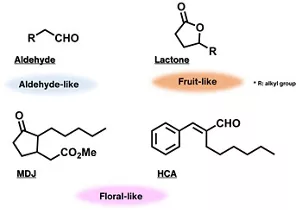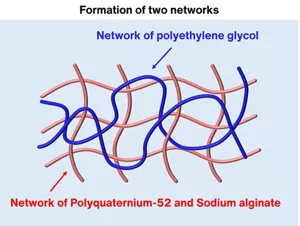Functional Materials
Material Development
Kao uses material-synthesis and composite technologies to make functional materials such as fragrances and polymers that are widely used in daily necessities and chemicals.
Synthetic fragrances are one group of materials essential for producing aromas. By developing safe, simple, and environmentally friendly technologies for manufacturing synthetic fragrances (Figure 1), Kao provides basic synthetic fragrances such as aldehyde, lactone, methyl dihydrojasmonate (MDJ), and hexyl cinnamic aldehyde (HCA) (Figure 2) worldwide. Recently, we have been conducting research to create new value for fragrance products by combining synthetic fragrances.

Figure 1 Development of technologies for manufacturing synthetic fragrances

Figure 2 Typical basic synthetic fragrances
In the field of polymer chemistry, various functional materials such as surfactant polymers, surface-modified polymers, and hydrogels have been developed. For example, Polyquaternium-52 is a surface-modified polymer that lubricates the surface of a material and is used in a wide range of products.
We mixed Polyquaternium-52, sodium alginate, and polyethylene glycol to develop a new hydrogel with two networks (Figure 3). This hydrogel exhibits high durability as well as lubricity. We found that by applying this technology to hair care products, hair stays smooth after shampooing or exposure to friction and prevents hair from tangling.
We will apply this technology to various products, including hair care products.

Figure 3 Networks in the hydrogel (conceptual diagram)
- Home
- Innovation
- Research & Development
- Fundamental Research
- Material Science
- Functional Materials
- Home
- Innovation
- Research & Development
- Fundamental Research
- Material Science
- Functional Materials
